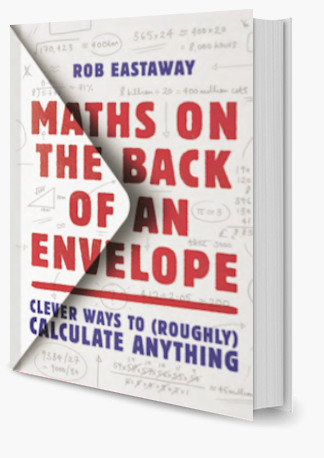
A book about mental arithmetic? By Rob Eastaway? Count me in! In my fuzzy mental Euler diagram of topics and authors, Maths On The Back Of An Envelope lies in the intersection of several ‘favourite’ circles.
Perhaps paradoxically, this meant I was expecting to be a little disappointed: how can a book, by an author I admire, on a topic I both love and have Strong Opinions about, live up to what I’d like it to be? Luckily, Eastaway’s writing is excellent, even taking into account that you expect it to be excellent.
The main thrust of the book is to encourage readers to make peace with the uncertainty inherent in calculations – to make finger-in-the-wind estimates, to round numbers recklessly, to embrace estimation as the sledgehammer of one’s mathematical toolkit. It guides readers towards the skills they need to do that, with plenty of examples and challenges.
(I’m given to understand that the Mathematical Ninja also took a lot of enjoyment out of Envelope; they tackled the questions with an attitude of “I can estimate this better still!”, which isn’t exactly in the spirit of the thing, but it kept them entertained for a bit.)
One of the key methods for estimating is what Eastaway calls zequals, a more-or-less formal set of steps for rough calculation, which boil down to “always round to one significant figure”. Is it accurate? Good grief, no. Is it good enough most of the time? Absolutely. The book looks at a few places where the numbers might go squiffy
For me, this is an area I’d have liked to see a little more detail in; I can envisage cases – for example, dividing by a small difference – where zequals would give an answer significantly removed from the correct one; I suspect a chapter on “how to refine your zequals estimates” would have taken the book beyond its remit.
I also enjoyed the section on Fermi estimation, which is full of questions you can find reasonable answers to without knowing very many details at all. The tone, throughout the book, is light, cheery and encouraging; the examples he picks are backed up with stories and details that draw the reader in – one can’t help but wonder how many tennis balls are used at Wimbledon, or the area of the Atlantic Ocean.
In short, this is a great book for anyone with a passing interest in getting better at maths – by which I mean, not so much the traditional, algorithmic, get-a-precise-answer arithmetic maths as “look at a problem and figure out what to do” maths. As such, I’d recommend it especially for anyone tackling Core Maths post-16, or trying to get back into maths after a break.
Colin, for once, didn’t freeload a review copy of this and bought his own.